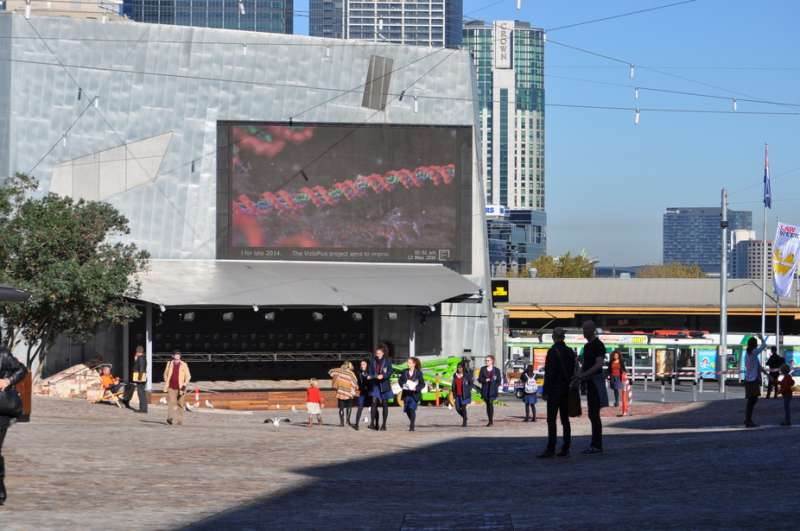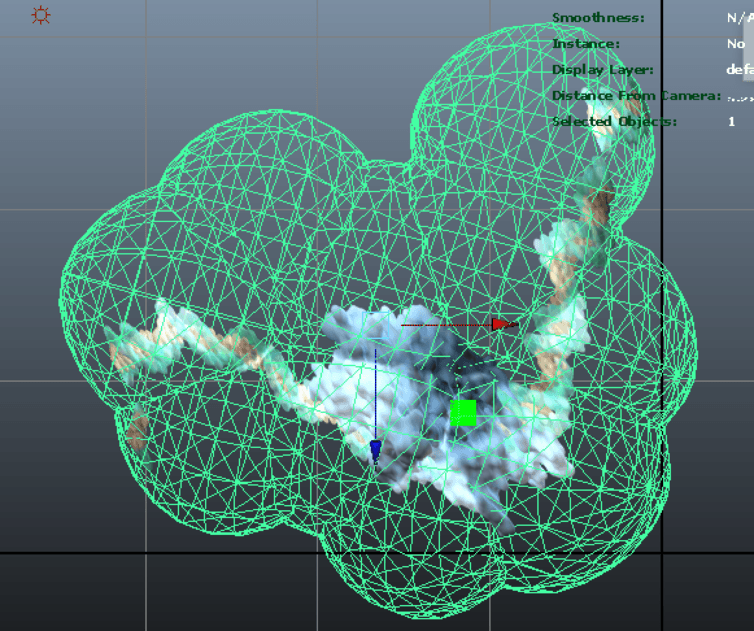Science by stealth: secret missions of a visual science communicator

There once was a DNA molecule, magnified 250 million times. Its mutated form hovered above Federation Square, Melbourne, perceived only subliminally by many of the transient pedestrians below.
As a visual science communicator, science by stealth is one of my most powerful strategies. Using striking visuals, and some opportunistic positioning, it is not that hard to inject just a little taste of hard-core molecular biology into the lives of every day people who are not traditionally interested in science.
On the topic of science by stealth, science communicator Dr Craig Cormick with Kylie Sturgess in 2013 said "We're very good at getting the converted more engaged and more interested in science. But I think we have trouble reaching those in the next category down the line that are marginally interested or occasionally uninterested. So, the challenge I find is often, how do you have a conversation about science that's not apparently about science, that has a lot of science intrinsically built in its content… …science by stealth is often the answer."
Visual science communication is more than just transmitting knowledge.
One of the turning points of my career was seeing my animation of mutated DNA broadcast on the big screen at Federation Square, Melbourne. The animation appeared nude - stripped of its voice-over and sound effects that I had worked hard to perfect. The core messages and full educational value of the story about cancer DNA were completely lost. But still, people looked, and in doing so, accidentally or even subliminally encountered just a little taste of molecular biology.
I was not interested in the number of views my animation received, nor the quality of the reviews on that day. At this time I realised how cool it felt to have my animations seen by completely unsuspecting audiences.
This was my first taste of science by stealth.
Biomedical animations are designed to be scientifically accurate but also aesthetically pleasing. When the narrative is well aligned with the visual, the stories can be very engaging and informative. Visuals have been used historically to transmit knowledge to audiences ever since humans began to observe and document the world around them. However, using visuals to transmit knowledge about science to an audience is just one aspect of visual science communication.
Non-knowledge objectives
Associate Professors John Besley and Anthony Dudo are science communication researchers who believe that there is more to science communication than transmitting knowledge.

"Things like fostering excitement about science, building trust in the scientific community, or reframing how people think about certain issues." Are referred to as non-knowledge objectives. Fostering positive views about science requires more than just trying to correct deficits in public knowledge.
My biomedical animations have been salami sliced in so many ways and for so many purposes beyond the original intended objective of knowledge transmission that I have seen many unexpected positive outcomes from this delicatessen of molecular imagery.
Facilitating conversation
Art and Design students whom I teach are regularly exposed to science by stealth. I use examples from structural biology and epigenetics to discuss the process of 3-D modelling and animation. In this way visual science communication facilitates conversation.
Through deconstructing the animation process, I can talk about the dynamics of molecular interactions. By unpacking the role of the artist in biomedical animation I talk about scale, colour and representing scientific uncertainty.
In this example, it is the process of creating an animation that directs the conversation but the polished, highly rendered, accurate molecular models can be intimidating. In some cases, these resolved, completed animations are not the best visual vehicles for a conversation.
What does generate conversation, and at times cult-like following are punchy, sketchy, sometimes humorous hand drawn animations. Animations where its obvious that a human has created the visuals, rather than a computer. Somehow the old-school and nostalgic appeal of these types of animations can engage an audience in a way high tech 3-D animations can't.
Fostering relationships
It seems that people don't feel intimidated by the monochrome sketches created as part of the animation planning process. When shown both the sketchy prototype of the cancer-associated protein p53 alongside the polished and rendered final cut, people point to the sketch and ask about it. They ask what the different 'blobs' are, why its grey and what that 'stuff' is in the background. The same 'stuff' that appears in the highly rendered version but without the obvious human contribution that is so recognisable in a sketch.
The non-knowledge objectives of science communication feel less tangible and are definitely harder to evaluate than the traditional knowledge-transmitting objectives. As a scientist, it is so tempting to rely only on the more measurable, quantitative outcomes like number of views or knowledge gained. But visual science communication is more than transmitting knowledge. I'm convinced that we need to look more to these non-knowledge objectives to evaluate the true impact of visual science communication.
Source: The Conversation
This article was originally published on The Conversation. Read the original article.
![]()





















